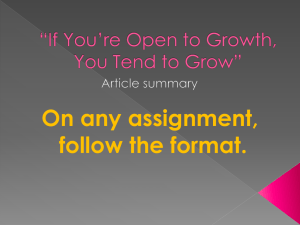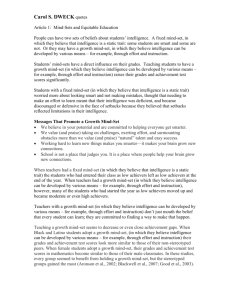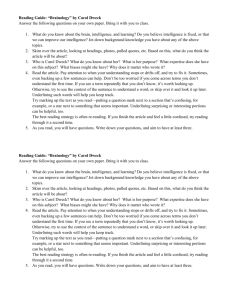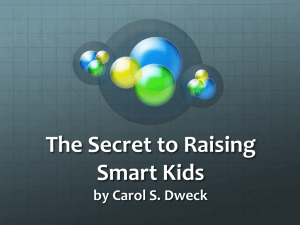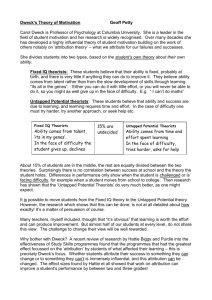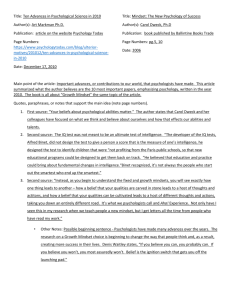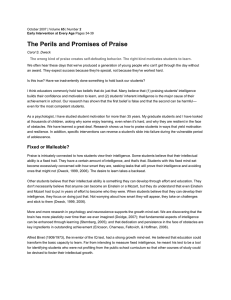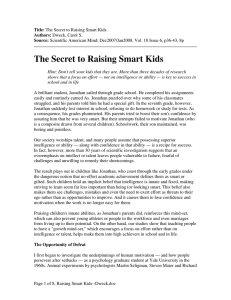and-Students’-Mind
advertisement
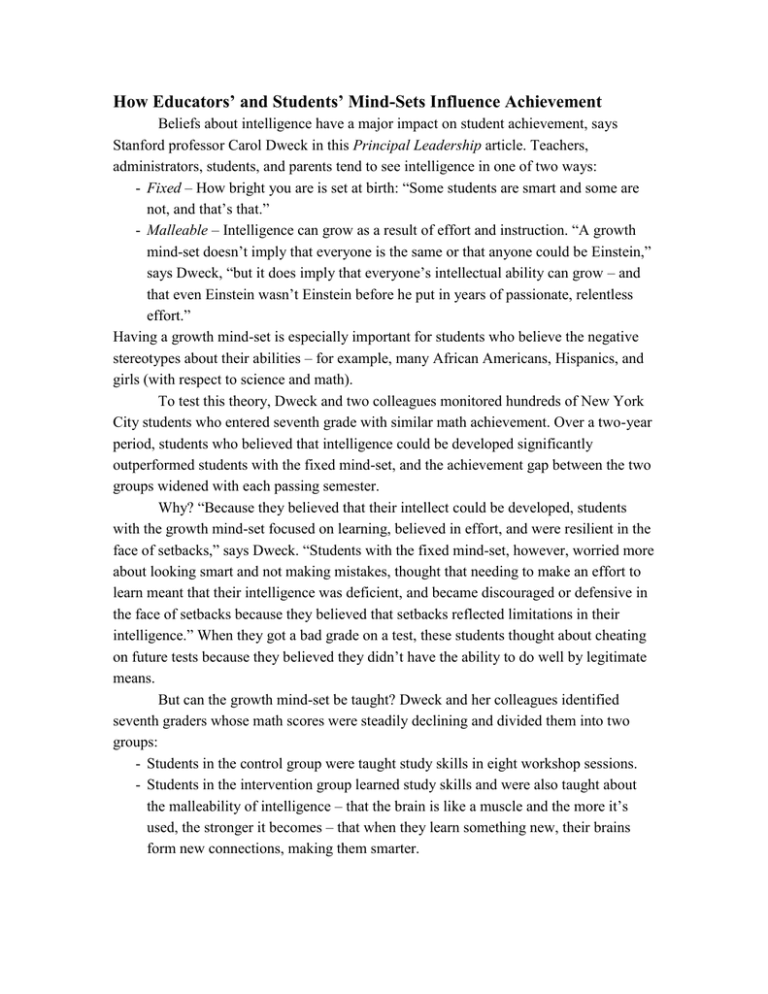
How Educators’ and Students’ Mind-Sets Influence Achievement Beliefs about intelligence have a major impact on student achievement, says Stanford professor Carol Dweck in this Principal Leadership article. Teachers, administrators, students, and parents tend to see intelligence in one of two ways: - Fixed – How bright you are is set at birth: “Some students are smart and some are not, and that’s that.” - Malleable – Intelligence can grow as a result of effort and instruction. “A growth mind-set doesn’t imply that everyone is the same or that anyone could be Einstein,” says Dweck, “but it does imply that everyone’s intellectual ability can grow – and that even Einstein wasn’t Einstein before he put in years of passionate, relentless effort.” Having a growth mind-set is especially important for students who believe the negative stereotypes about their abilities – for example, many African Americans, Hispanics, and girls (with respect to science and math). To test this theory, Dweck and two colleagues monitored hundreds of New York City students who entered seventh grade with similar math achievement. Over a two-year period, students who believed that intelligence could be developed significantly outperformed students with the fixed mind-set, and the achievement gap between the two groups widened with each passing semester. Why? “Because they believed that their intellect could be developed, students with the growth mind-set focused on learning, believed in effort, and were resilient in the face of setbacks,” says Dweck. “Students with the fixed mind-set, however, worried more about looking smart and not making mistakes, thought that needing to make an effort to learn meant that their intelligence was deficient, and became discouraged or defensive in the face of setbacks because they believed that setbacks reflected limitations in their intelligence.” When they got a bad grade on a test, these students thought about cheating on future tests because they believed they didn’t have the ability to do well by legitimate means. But can the growth mind-set be taught? Dweck and her colleagues identified seventh graders whose math scores were steadily declining and divided them into two groups: - Students in the control group were taught study skills in eight workshop sessions. - Students in the intervention group learned study skills and were also taught about the malleability of intelligence – that the brain is like a muscle and the more it’s used, the stronger it becomes – that when they learn something new, their brains form new connections, making them smarter. “Students were galvanized by the idea that the growth of their minds was under their control,” says Dweck. One boy who had been a troublemaker heard this message and said, “You mean I don’t have to be dumb?” What were the results of the study? The math achievement of students in the control group continued to get worse, despite instruction in study skills. Control-group students, on the other hand, showed marked improvement. Teachers (who didn’t know which students were in which group), immediately noticed the difference in controlgroup students’ attentiveness, study habits, motivation, homework completion, and achievement. Dweck was so impressed with the results of this study (and others like it) that she and her colleagues developed Brainology, a software program designed to teach students the growth mind-set, and tested it in 20 New York City schools. Virtually all students reported positive changes in their ideas about learning and study habits. “Most exciting,” says Dweck, “many reported using the image of their neurons making new connections to motivate themselves in school, saying that they pictured their neurons forming new connections when they paid attention in class and that when tempted to not study, they rejected that idea on the grounds that new connections would not be formed.” What about teachers’ mind-sets? Dweck reports a German study showing that low-achieving students who had teachers with the fixed-ability mindset made no progress, whereas students with teachers with the growth mindset improved to become moderate or high achievers. Dweck has found that adults with the fixed-intelligence mindset tend to make snap judgments, quickly putting people into categories. “This means that once they have decided that someone is or is not capable,” she says, “they are not very open to new information to the contrary… When teachers decide that certain students are not capable (or when principals decide that certain teachers are not capable), they may not take steps to help them develop their potential.” The differences in how students are treated by different teachers is stark. For example, when dealing with a student who just failed the first math test of the year, a fixed-mindset teacher typically comforts the student and says that not everyone can be good at math. A growth-mindset teacher tells the student he or she can do better, offers encouragement, and teaches specific learning strategies and study skills. Students are quick to pick up on their teachers’ beliefs, says Dweck, as was demonstrated by a study of college athletes. “The more that athletes thought their coaches believed in hard work over natural talent,” she says, “the better the athletes did that year. Students know what educators value – they pick up their messages and act on them… It is essential for educators to communicate that they hold a growth mind-set.” The way adults deliver praise is particularly powerful in shaping their mindsets. “When adults praise students’ intelligence after a student performs well,” says Dweck, “they send a fixed mind-set message: you’re intelligent and that’s what I value in you. When adults praise effort (or strategies), however, they send a growth mind-set message: you can build your abilities through effort.” Students who are praised for ability go to pieces when they fail or encounter frustrating tasks. Students who are praised for effort are undaunted by challenges and continue to improve. Recent studies show that teachers’ mind-sets are key to closing the achievement gap. Students who believe that ability is fixed are haunted and discouraged if they believe their race or gender is less able. But students who see ability as malleable, even if they know their race or gender has underperformed historically, are willing to work on changing history through effective effort and working with their teachers. “When black and Latino students adopt a growth mind-set,” says Dweck, “their grades and achievement test scores look more similar to those of their non-stereotyped peers. When female students adopt a growth mind-set, their grades and achievement test scores in mathematics become similar to those of their male classmates. In these studies, every group seemed to benefit from holding a growth mind-set, but the stereotyped groups gained the most.” “Mind-Sets and Equitable Education” by Carol Dweck in Principal Leadership, January 2010
